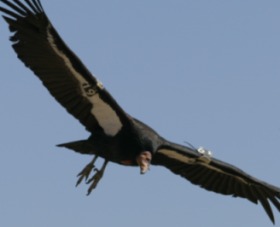Committee Approves Bill on California Condor Carrion

N ew rules for feeding the Golden State’s wild California condors were unanimously approved March 23 by the Assembly Committee on Water, Parks and Wildlife .
Among the requirements, give North America’s largest bird only euthanized livestock killed with non-lead ammunition, animals that die of natural causes and wildlife killed by traffic.
Although 87 condors ply the skies of California – up from 22 in 1982 – they need help finding food, supporters of the state’s condor recovery program say, because young condors, particularly those raised in captivity, don’t know where to find food on their own.
The measure, AB 1956 by Assemblyman Bill Monning, a Santa Cruz Democrat, is aimed at helping non-profit groups who aid in increasing the number of condors in the wild.
A problem in feeding the condors is that existing law prohibits transporting a dead animal from one person’s property to another. The only acceptable destinations for a carcass are a rendering plant, an animal disease laboratory, crematory or collection center.
Monning’s measure exempts the Department of Fish and Game, which helps coordinate California’s condor recovery efforts, from those transport restrictions – when they are providing food for condors.
To avoid what one legislative staffer describes as the “ick factor” of rotting carrion, condor feeding areas must be located on properties of 100 acres or more and be set back at least one-half mile from the property line.
The measure also requires that any contract let between the Department of Fish and Game and condor caregivers, such as Ventana Wildlife Society in Monning’s district, insist the feeding area be on a “hill or knoll predominantly covered by grass and not under a tree canopy or within 100 feet of a stream, lake or other body of water.”
The bill also says the feeding area must be a “safe distance from nearby hazards, including, but not limited to, turbines or overhead wires.”
After California condors were reintroduced into the wild in 1992, five died after colliding with power lines.
In response, breeders of captive condors, which include the Los Angeles Zoo and the Zoological Society of San Diego, began a power pole aversion program.
A fake power pole was placed in the pen where young condors stay before being released. The pole gives the condors an electric shock when they try to land on it, causing the birds to seek a natural perch. Condor power line deaths have fallen as a consequence, according to a 2000 article in the Endangered Species Bulletin.
The reason for using only cows killed with non-lead bullets is that condors are very susceptible to lead toxicity. Ten condor deaths have occurred from lead poisoning in Arizona and California. Lead is the leading killer of condors in the wild.
Initially, firearms retailers and several shooting sports groups opposed the bill because it appeared to use fees paid by hunters into the Fish and Game Preservation Fund to feed non-game birds, mammals and fish.
Monning axed the language from his bill, winning support from Republicans on the committee.
Condors have inhabited North America for more than 50,000 years. Like former Senate President Pro Tempore John Burton, California condors date back to before the Pleistocene Epoch.
Once ranging over much of North America, condors begin to dwindle because of lead poisoning, illegal shooting and loss of habitat.
The less than two-dozen surviving birds were captured and in 1987 and bred.
Since 1992, in California they have been re-introduced into the mountains north of the Los Angeles, near Big Sur on the Central Coast and in Pinnacles National Monument. Condors have also been released in Arizona and Baja. Seventy-five and 19, respectively.
In all, there are 180 condors in the wild and another 171 in captivity.
Monning’s bill must pass the full Assembly and the Senate before going to Gov. Arnold Schwarzenegger. The GOp governor has taken no public position on the measure.
-30-
Filed under: Legislature/Legislation
Capitol Cliches Conversational Currency Great Moments in Capitol History News Budget and Economy California History Demographics Fundraising Governor Legislature/Legislation Politics State Agencies
Opinionation Overheard Today's Latin Lesson
Restaurant Raconteur Spotlight Trip to Tokyo Venting Warren Buffett Welcome Words That Aren't Heard in Committee Enough

Who says the legislature can’t get business done? Now on to the Apple Moth and kangaroo hides!
Comment by Jim Cassie — 3.23.2010 @ 3:09 pm
Are there any takers as to whether John Burton will be here after the condors are gone?
Comment by Wiliam Strunk, Jr. — 3.23.2010 @ 6:13 pm